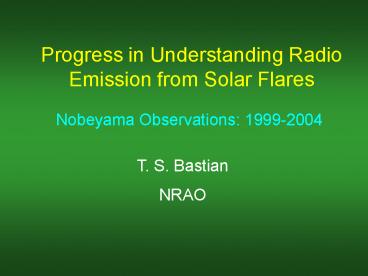Progress in Understanding Radio Emission from Solar Flares - PowerPoint PPT Presentation
Title:
Progress in Understanding Radio Emission from Solar Flares
Description:
Sample of 412 OVSA events (1.2-18 GHZ) ... Greyscale:-12 kev; Contours: 25-50 keV. Coronal thick-target flares. Veronig & Brown 2004 ... – PowerPoint PPT presentation
Number of Views:24
Avg rating:3.0/5.0
Title: Progress in Understanding Radio Emission from Solar Flares
1
Progress in Understanding Radio Emission from
Solar Flares
Nobeyama Observations 1999-2004
T. S. Bastian NRAO
2
Flares and Particle Acceleration
Energetic electrons Nakajima, Masuda, Takasaki
Gyrosynchrotron emission Fleishman
Electron acceleration transport Melnikov, Pohjolainen, Huang, Tanuma
Pulsations, oscillations, periodic injection Asai, Kamio, Stepanov
Spatial and temporal fine structures Altyntsev
NoRH/RHESSI results Hudson, White, Kundu, Hori, Nindos
3
Focus on developments since 1998
Date of the last Nobeyama Symposium
- Taxonomy of radio bursts
- Electron injection and transport
- TPP/DP model
- Electron anisotropies
- Loop top acceleration
- Dense flares
- Cold flares
4
Statistical study of spectral properties of dm-cm
l radio bursts
Nita et al 2004
- Sample of 412 OVSA events (1.2-18 GHZ)
- Events are the superposition of cm-l (gt2.6 GHz)
and dm-l (lt2.6 GHz) components - Pure C 80 Pure D 5 Composite CD 15
- For CD events 12 (lt100 sfu) 19 (100-1000
sfu) 60 (gt1000 sfu) - No evidence for harmonic structure
5
from Nita et al 2004
6
(No Transcript)
7
Trap plus Precipitation Model (TPP)
Melrose Brown 1976
Trap plus Precipitation and Direct Precipitation
Model (TPP/DP)
Aschwanden 1998
Number trapped electrons
Number electrons precipitating from trap
Loss cone angle
Number trapped electrons
Number electrons precipitating from trap plus
directly precipitating electrons
8
TPP/DP Model
from Aschwanden 1998
9
from Aschwanden 1998
10
(No Transcript)
11
Bastian et al 1998
12
1998 May 8
NoRH Yohkoh
2000 January 12
Kundu et al 1998a
13
1998 June 13
NoRH
Kundu et al. 2001a
14
1998 June 13
Kundu et al. 2001a
15
OVSA
1993 June 3
Lee, Gary, Shibasaki 2000
16
1993 June 3
OVSA/NoRH
Trap properties
Lee, Gary, Shibasaki 2000
A comparison of successive flares yielded trap
densities of 5 x 109 cm-3 in the first, and 8 x
1010 cm-3 in the second.
Anisotropic injection
Lee Gary 2000
Showed that the electron injection in the first
flare was best fit by a beamed pitch angle
distribution.
17
1993 June 3
OVSA
mo0
Lee Gary 2000
18
1999 May 29
White et al 2002
19
White et al 2002
20
Gyrosynchrotron radiation from anisotropic
electrons
Fleishman Melnikov 2003ab
QT
QP
Properties of the emitted radiation e.g.,
intensity, optically thin spectral index, degree
of polarization depend sensitively on the type
and degree of electron anistropy
h cos q
21
The existence of loop top sources is undeniable.
The most natural explanation is that an
anisotropic distribution of electrons is trapped
near the loop top. Are anisotropic electron
distributions made (via transport) or born
(via acceleration injection)? Or both?
22
Dynamic trap
Aschwanden 2004
Motivation Account for energy-independent
electron injection into flaring loop.
23
Collapsing trap
Karlický Kosugi 2004
- Analysis of betatron acceleration of electrons
due to relaxation of post-reconnection magnetic
field lines. - Energies electrons and producers highly
anisotropic distribution
Model electron properties near footpoint
24
X5.6 flare on 2001 April 6
Qiu, Lee, Gary 2004
25
Fast propagation of nonthermal source
Yokoyama et al. 2002
26
6000 km/s
90000 km/s
from Yokoyama et al 2002
27
Veronig Brown 2004
A new class of HXR source, not to be confused
with Masuda type source.
28
2002 April 14
Coronal thick-target flares
Veronig Brown 2004
- Two examples presented of gradual flares wherein
the corona is collisionally thick. - Electron distribution function, while steep (d
6-7) is definitely non-thermal (NoRH) - Column depth f 5 x 1020 cm-2
- Eloop8.8 f191/2 (keV)
- These flares have Eloop50-60 keV!
- The implied coronal density of thermal plasma is
nth 2 x 1011 cm-3
Note Magnetic field required to confine plasma
becoming large. See Shibasaki (2001).
Greyscale-12 kev Contours 25-50 keV
29
Cold flares
Hudson Ryans (1995) Impulse response flares
- First pointed out by White et al (1992).
- Simple impulsive profile
- Flat spectrum
- Sharp low frequency cutoff
- No SXRs!
from White et al 1992
30
24 October 2001
AR 9672
31
(No Transcript)
32
(No Transcript)
33
(No Transcript)
34
B300 nth1.5 x 1011 nrl5 x 106 E1100 keV E22
MeV d3.5
35
Concluding Remarks
but no conclusions
TPP/DP model a useful framework for understanding
microwave and HXR observations A new appreciation
for the importance of anisotropic electron
distributions demands a revision of the tools we
use to interpret the observations New classes of
flares are being recognized as new observational
tools have become available NoRH RHESSI These
place new or additional demands on electron
acceleration mechanisms
36
(No Transcript)
37
(No Transcript)
38
(No Transcript)
39
(No Transcript)
40
Study of dm-spikes and ml GS bursts
Fleishman et al 2003
Conclude that spikes produced by spectrally hard,
anisotropic, trapped electron distribution
41
(No Transcript)
42
(No Transcript)

